LED Bollard Lights: Everything You Need to Know
Table of Contents
Are you seeking a way to brighten those dim walkways or your parking area? Consider LED bollard lights as your go-to solution!
Ideally suited for residential and commercial settings, LED bollard lights facilitate secure pedestrian movement and enhance nighttime visibility. The energy-efficient LED technology in these fixtures allows for continuous illumination without a surge in electricity bills. Moreover, their diverse shapes and styles can significantly elevate the aesthetic of your surrounding landscape.
We have curated an extensive guide to LED bollard lights in this feature. Delve into the various categories of LED bollard lights, the available materials and designs, the installation procedures, and much more. Prepare yourself to explore the vibrant world of LED bollard lights-
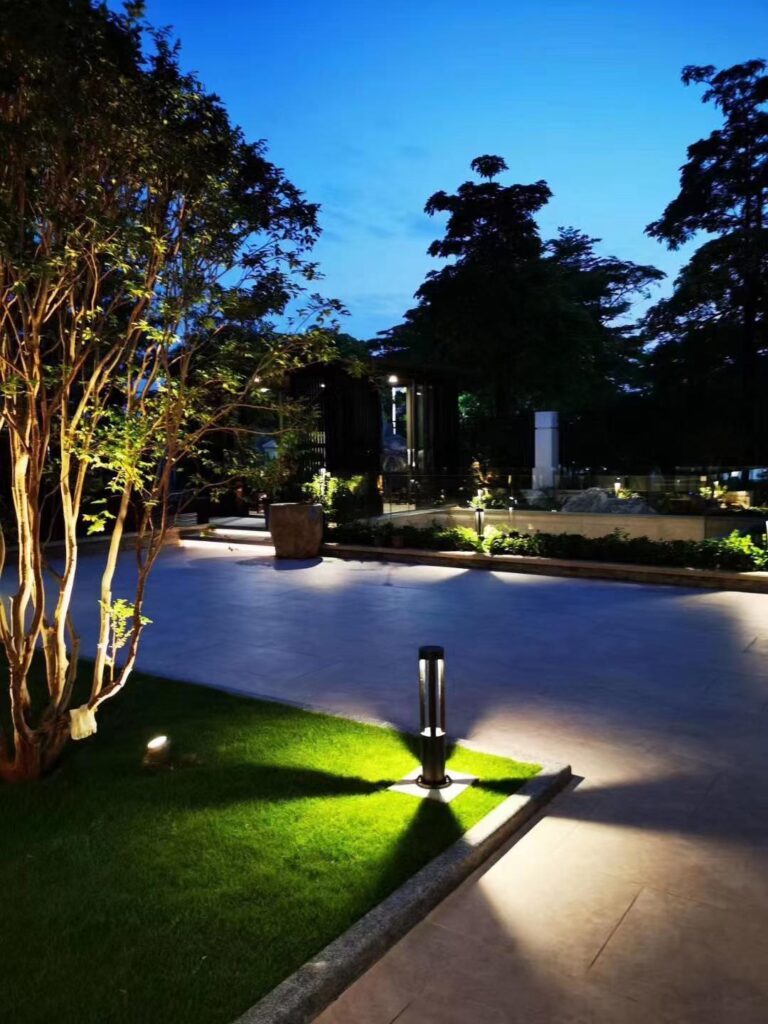
Understanding LED Bollard Lights
LED bollard lights, available in compact, square, or round designs, are typically installed outdoors to light up pathways, patios, and landscapes for safer nocturnal traversals. Generally rising to two to three feet, these fixtures house a light source at their top and sides, making them versatile for various residential, commercial, and multifaceted applications.
While other non-LED alternatives like High-Intensity Discharge (HID) lamps and Compact Fluorescent Lamps (CFL) are also present in the market, LEDs remain a favorite owing to their superior energy efficiency and cutting-edge features, including motion sensors and dimming capabilities.
Why Opt for LED Bollard Lights?
The foremost objective of utilizing LED bollard lights is to promote safety and enhance visibility. Beyond this central purpose, they serve several roles in brightening outdoor residential, commercial, and public spaces, as highlighted below-
Illumination: Their chief role is to provide ample illumination during the night, facilitating safe passage. Essentially miniature lampposts, they cast sufficient light on walkways, promoting unhindered movement in the dark.
Safety and Security: By lighting up areas effectively, they deter unauthorized individuals or potential intruders, acting as a passive security system that enables easy identification of suspicious activities.
Boundary Demarcation: LED bollard lights can delineate property boundaries sophisticatedly. It is essential, however, to adhere to local guidelines to prevent inconveniences to neighbors or passersby.
Landscape Augmentation: Besides enhancing safety, these lights can spotlight landscape elements such as gardens or trees, accentuate architectural details, and foster a visually pleasing ambiance. By introducing depth and texture, they boost the aesthetic allure of outdoor spaces.
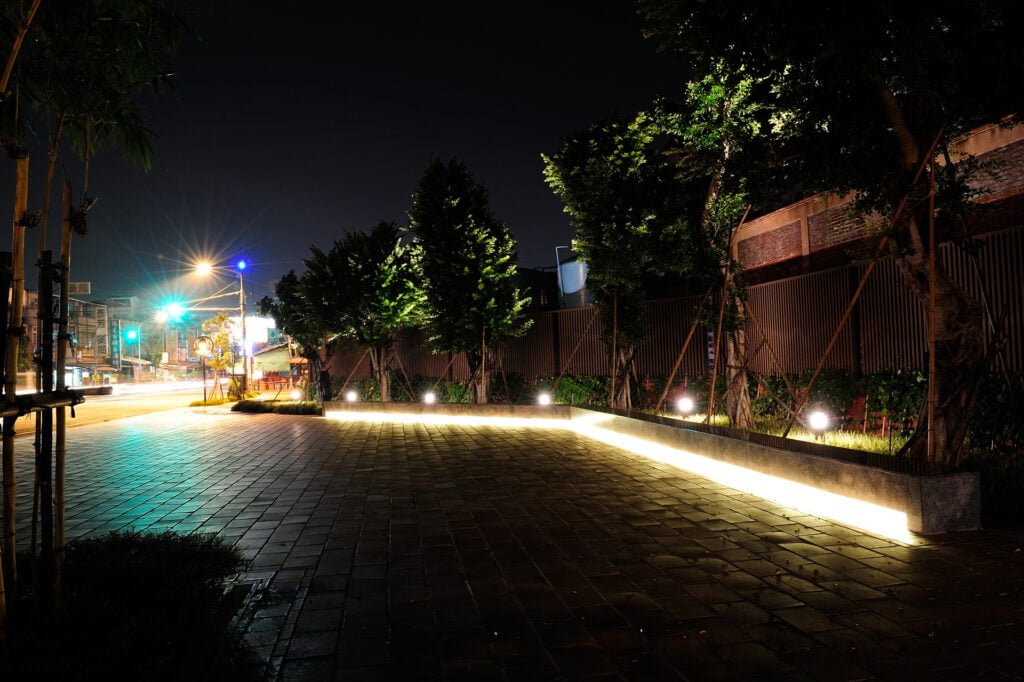
Varieties of LED Bollard Lights
The range of LED bollard light designs is ever-expanding. Available in a range of materials, including wood, steel, and concrete, they also incorporate advancements like motion sensors and variable lighting patterns, broadening the scope of this category significantly. Below, I have delineated the main categories of LED bollard lights for your consideration:
Material-Based Categories
Depending on the constituent material, LED bollard lights can be classified into four main types:
- Stainless Steel Driveway Bollard Lights Crafted with SUS304 and SUS316 materials, these bollard lights boast resistance to both impacts and corrosion. Their durability makes them ideal for seaside locations or areas with high humidity and hot climates, with a high risk of collision and rusting.
- Concrete LED Bollard Lights Notable for their sleek aesthetic and superior mechanical strength, concrete bollard lights offer a robust solution for parks, parking lots, and walkways. Their customizable concrete finishes and reinforced structure (using stainless steel or fibers) allow for increased strength and versatility in design.
- Aluminum LED Bollard Lights These fixtures offer a modern and elegant look, making them suitable for residential and commercial applications. Apart from being more affordable than their stainless steel counterparts, they are also lightweight, facilitating more straightforward installation.
- Wooden LED Bollard Lights These bollard lights complement architectural designs with a natural or rustic theme. Commonly found in pathways and gardens of rural-themed hotels and resorts, they seamlessly blend with the surroundings, offering a unique aesthetic appeal.
Voltage-Based Categories
Depending on their voltage specifications, LED bollard lights can be of two types:
- Low Voltage LED Bollard Lights Operating at a mere 12V, these energy-efficient fixtures are a safe and cost-effective lighting solution, especially for wet locations or playgrounds. Besides being easy to install, they are portable and more affordable than other types.
- Line Voltage Bollard Lights Operating at 120V, these lights can illuminate more extensive areas, making them ideal for commercial outdoor spaces. Despite being pricier and necessitating professional installation, they offer bright and consistent lighting, usually required in high-security areas like parking lots.
Usage-Based Categories
Based on their utility, bollard lights can be classified into four categories:
- Commercial Pathway Bollard Lights These versatile lighting solutions are becoming increasingly popular in urban and suburban locales, gracing spaces such as hotels, parks, and outdoor events with modern and sleek designs.
- Residential Landscape LED Bollards To enhance the outdoor ambiance of your home, opt for these bollards that come in various designs, perfectly aligning with your home’s aesthetic while illuminating gardens, driveways, and other outdoor spaces.
- Decorative LED Bollard Lighting Ideal for events and community centers, these bollards enhance the beauty of any area with their captivating designs. They can also restrict unique indoor spaces, like museum exhibits.
- Solar-Powered Bollard Lights: A rising trend in garden lighting, these energy-efficient fixtures are available in various modern and vintage designs, catering to different stylistic preferences.
I hope this revised text meets your requirements. Let me know if you would like any specific changes or additions.
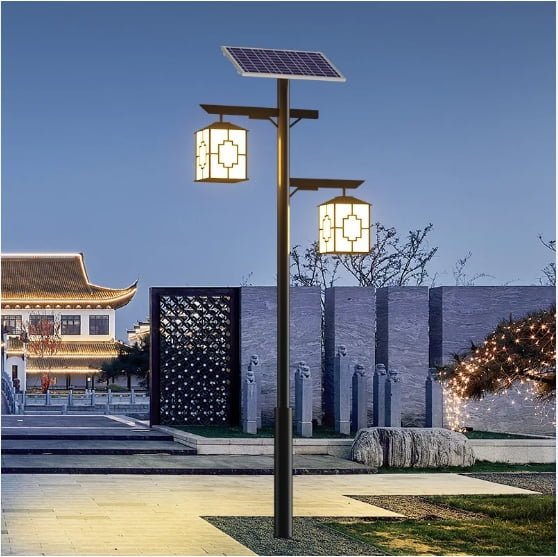
Categorizing by Lens Varieties
LED bollard lights offer diverse optic characteristics, encompassing a range of lens types that dictate their lighting patterns. Four prominent categories of LED bollard lights are prevalent, namely:
1. Louver LED Bollard Light
These bollard lights guide their luminosity downward, concentrating on the ground below. This approach reduces glare while creating a warm and inviting light ambiance. Nestled at the pinnacle of the post and angled downwards, these LEDs are a prime choice for illuminating parks, pathways, and various outdoor settings.
2. Bollard Light Featuring Type V Glass Reflector
Equipped with a type V glass reflector, this variant disperses a diffuse luminosity in a full circle, catering well to spaces requiring heightened security measures, such as parks, roadways, and pathways. These installations radiate a bright light encompassing a large area, necessitating only a handful of fixtures to illuminate a substantial space. Additionally, shades modulating the radiated light can prevent undue light spillage, maintaining a controlled lighting environment.
3. Bollard Light with Conventional Cone Reflector
Manifesting a gentle and evenly distributed light over a 360-degree radius, the conventional cone reflector is synonymous with low luminescent output yet adequate area illumination surrounding the installation. Its classic aesthetics, which cleverly obscure the light source, make it a preferred option for those seeking a touch of tradition in their lighting choices.
4. Bollard Light with Specialized Cone Reflector
This variety of bollard light employs a specialized cone reflector to channel the light toward the cone, rebounding downward and disseminating a seamless, glare-free luminance. This mechanism aids in minimizing light pollution, offering a soothing and comfortable lit environment. Typically, these units incorporate tailored metal cones for enhanced efficacy, although aluminum variants are also revered for their proficiency in curbing glare.
Utilizing LED Bollard Lights
LED bollard lights serve numerous functions, and they are commonly deployed in the following contexts:
- Path Illumination: These lighting fixtures illuminate pathways, walkways, or the peripheries of house patios, business precincts, or public areas. Not only do they offer ample lighting, but they also accentuate architectural aesthetics.
- Boundary Marking: Strategically positioning bollard lights along the borders of parking spaces, roads, and property perimeters helps delineate boundaries. Consequently, this mitigates unwanted parking incidents and fosters the creation of safe pedestrian zones.
- Driveway Lighting: Within the driveways of hotels, resorts, shopping centers, corporate buildings, or other public spaces, LED bollard lights facilitate safer nighttime driving conditions by enhancing visibility and pedestrian safety, particularly during dark hours.
- Parking Lot Zoning: These lights are commonplace in parking lots, serving as indicators of parking areas or segregating the space into various sections.
- Entrances and Facades: LED bollard lights are often employed to illuminate the entryways or facades of residential or commercial premises, adding a layer of elegance and security.
- Garden Illumination: Gardens can appear somewhat lackluster at night; however, installing LED bollard lights around garden boundaries can elevate the atmosphere significantly. These installations amplify the garden’s appeal and bestow a magical aura during the night. Solar LED bollards are particularly suited for garden settings.
- Restricting Access to Specific Zones: LED bollard lights can also act as barriers to demarcate restricted or under-maintenance areas, establishing physical and visual barriers to deter unauthorized access.
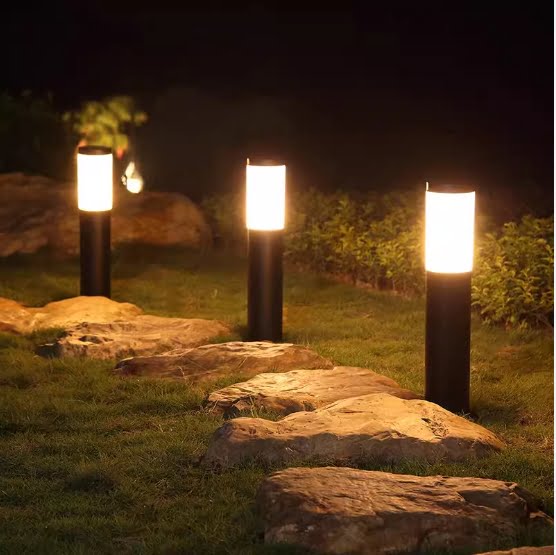
Advantages of Opting for LED Bollard Lighting

Opting for LED bollard lights offers many advantages compared to traditional pathway illumination solutions. Here are several compelling reasons why:
Eco-Friendly
Unlike conventional fluorescent or incandescent lamps that release harmful gases, LED bollard lights are an environmentally friendly choice. Thanks to the technology that powers them, they remain cool to the touch, last significantly longer, and leave a smaller carbon footprint.
Extended Durability
Built to last, the solid construction of bollard lights guarantees longevity. The LED units housed within can function for more than 50,000 hours, reducing the need for frequent replacements and thus proving to be a cost-effective solution in the long run.
Enhanced Efficiency
With technological advancements, modern LED bollard lights have become up to 90% more efficient than their traditional counterparts. They maximize energy usage by delivering higher lumens while consuming less power and generating less heat. Furthermore, their rugged build can withstand harsh weather conditions. Their adaptable nature allows customization to cater to your specific lighting requirements.
Minimal Maintenance
LED bollard lights save you time and significantly cut down on maintenance and replacement costs. While traditional HID or Halide lights were prone to wear and tear and were expensive to maintain, LED bollard lights compensate for their initial investment through savings on maintenance and energy bills without sacrificing lighting quality.
Diverse Design Options
LED bollard lights come in diverse designs, enabling you to find the perfect match for your architectural style. Whether aiming for a vintage ambiance along your home’s pathway with wooden bollard lights or prefer sleek black units with cone optic heads, the options available are virtually limitless, allowing for a personalized touch.
Selecting the Ideal LED Bollard Light: A Comprehensive Guide
When selecting LED bollard lights, understanding their unique configurations compared to regular LED fixtures is essential. To assist you in making an informed decision, here are some critical factors to bear in mind:
Crafting the Perfect Layout
To start, pinpoint the exact number of fixtures necessary to illuminate your designated space adequately. Establish a strategic layout by determining the precise spacing and number of units necessary to cover your desired area effectively.
Understanding Beam Angles
The beam angles of LED bollard lights vary significantly, ranging from 30 degrees to 360 degrees and even more. A more narrow beam angle provides intense, focused lighting, ideal for accentuating specific elements within a space. In contrast, a broader beam angle encompasses a larger area, making it suitable for general illumination. For instance, LED bollard lights with beam angles between 70° and 80° perfectly cater to parking lots, whereas a narrower beam angle might be better suited for decorative lighting purposes. Match the beam angle to your specific needs for optimal results.
Considering Voltage and Power
Voltage and power are critical, as they directly impact energy consumption. Opting for low-voltage bollard lights is a safer choice and more energy-efficient, making them excellent for damp locations and reducing your energy bills. These fixtures are also notably easier to install compared to their high-voltage counterparts.
Navigating Color Temperatures
LED bollard lights offer a spectrum of color temperatures to complement different tastes and preferences. Here’s a brief guide to help you choose:
- For a warm, inviting white light, opt for temperatures between 2700K and 3000K.
- If you prefer a brighter, more excellent white light, temperatures ranging from 3500K to 4100K would be ideal.
- Choose lights with temperatures between 5000K and 6500K for a natural daylight ambiance.
By considering these aspects carefully, you’ll be well on your way to choosing the perfect LED bollard light for your space.
| Light Color | Color Temperature |
| Warm White (Yellowish Light) | 2700K and 3000K |
| Cool White (Bluish Light) | 3500K and 4100K |
| Natural Daylight | 5000K and 6500K |
Luminosity
It is essential to carefully choose the luminosity of your LED bollard lighting fixture, considering its intended use. The brightness of a light is quantified in lumens; a more excellent lumen value indicates a more intense illumination. It’s generally recommended to opt for bollard lights with a higher luminance to ensure safety. Nevertheless, avoid excessively bright lights to prevent eye strain. Below, you will find suggestions for lumen ratings tailored to various applications:
| Location For LED Bollard Light | Lumen Rating |
| Pathway | 100 to 500 lumens |
| Parking Lot | 1,000 to 5,000 lumens |
| Garden Walkway | 50 to 500 lumens |
| Entrance & Facade | 100-1,000 lumens |
Material Choices
LED bollard lights are manufactured from various materials, including steel, wood, concrete, and aluminum. Your selection should hinge upon the intended use and the location where the light will be installed. For coastal or humid environments, opting for stainless steel LED bollard lights that offer superior resistance to corrosion and impacts is advisable. Moreover, to complement specific architectural styles, you may also select bollards made of wood or aluminum.
Dimensions
LED bollard lights are offered in various sizes to suit different environments. High-traffic, crowded locations generally necessitate taller fixtures, while compact bollards are apt for residential settings. Commercial bollard lights typically measure between 0.6m to 1.0m in height and feature diameters from 5″ to 8″. They are generally available in small, medium, and large sizes, though customization options are available to cater to individual preferences.
| Size Of Bollard Light | Height in Inches |
| Small | 8 to 24 inches |
| Medium | 25 to 38 inches |
| Large | 39 to 47 inches |
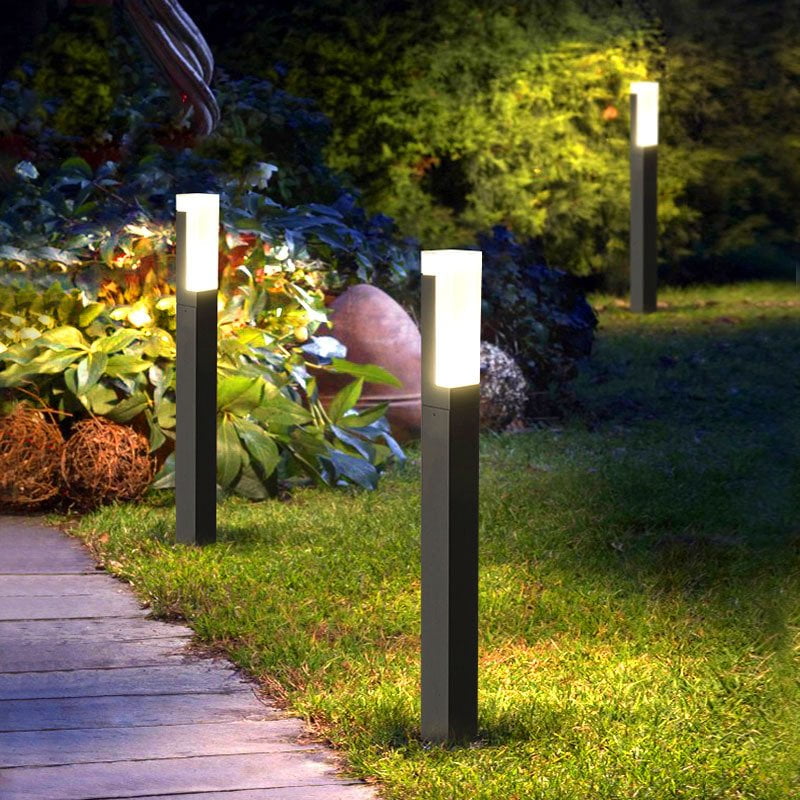
Understanding IP Ratings
IP ratings, denoting ‘Ingress Protection,’ measure the level of defense a product offers against the entry of solids and liquids. Since bollard lights are primarily designated for outdoor applications, they constantly grapple with dust, wind, and rain. Consequently, the importance of IP ratings in this context cannot be overstated. While LED bollard lights generally feature IP ratings between IP55 and IP65, it’s crucial to assess your specific needs to avoid unnecessary expenditure on higher-than-needed ratings. To delve deeper, refer to our detailed article – “IP Rating: The Definitive Guide.”
Insight into IK Ratings
The IK rating, standing for ‘Impact Kinetic,’ indicates the resilience of a lighting fixture to impacts and collisions. As bollard lights often find their place in driveways or pathways, they are susceptible to regular impacts—for instance, an accidental collision while parking your car. Securing a fixture with a higher IK rating guarantees enhanced durability. We recommend our article “IK Rating: The Definitive Guide” to further your understanding.
Choosing the Right Fixture Style
The market offers an array of LED bollard light designs, each promising to accentuate your space distinctively. The choices are plentiful, from modern, sleek aesthetics to a classic, vintage vibe. Moreover, you can opt for metallic or wooden finishes, lending a rustic charm to your premises. Nevertheless, it’s pivotal to harmonize your choice with the surrounding architectural elements and environmental backdrop.
Optimizing Light Coverage
The illumination and coverage span vary significantly among different bollard lights. To achieve comprehensive lighting, ensure an optimal distance between individual bollards and sufficient luminosity to bridge to the next unit. Note that the fixture size plays a vital role in determining the coverage area, with larger bollards offering a wider reach, spanning up to 120 cm compared to the 40-60 cm range of more minor variants.
Respecting Property Boundaries
When utilizing bollard lights to demarcate property lines, acquainting yourself with local government regulations is essential. This helps in ascertaining legal constraints and fostering a harmonious neighborhood relationship. Communicating with neighbors, particularly when the installation impacts their visual space, promotes mutual understanding and prevents disputes. Furthermore, a boundary survey might be beneficial in accurately delineating your property.
Budgetary Considerations
Several factors, including material composition, IP rating, luminosity, and additional features like motion sensors, influence the pricing spectrum of LED bollard lights. Moreover, installation entails substantial costs, especially since most setups require extensive groundwork. Therefore, considering the cumulative expense is prudent when purchasing LED bollard lights.
The Advantage of Customization
Embrace the flexibility customization options for LED bollard lights, facilitating a tailored lighting solution. Manufacturers offer adjustable beam angles, color temperatures, voltages, and styles, among other specifications—Partner with a reliable manufacturer to bring your customized lighting vision to fruition.
How to Successfully Set Up an LED Bollard Light
Mounting LED bollard lights can be a demanding task. It’s recommended to enlist the services of a trained professional for this project. Nonetheless, here’s a step-by-step guide to offer a glimpse into the installation process:
Step 1: Establish a Sturdy Base
Begin by crafting a solid foundation to anchor the LED bollard light to the ground securely. Commence with excavating a hole in the designated area; it should be about 2 feet deep and 1 foot in diameter, although adjustments might be necessary depending on the bollard fixture’s size. Next, position a tube within the hole, ensuring a portion remains above ground level. Utilize stones to stabilize and uphold the tube.
Step 2: Wire Setup
Ensuring safe and efficient wiring is vital for the installation. Lay down the necessary wires from the power source to the hole, maintaining the conduit and cables in a centralized and upright position. Having a generous length of wire will facilitate smoother connections at this stage. Leave excess wire at both ends to ease future adjustments. Remember to disconnect the power before engaging in any wiring activities. Also, equip yourself with safety glasses and gloves when handling cement and other tools. If you lack expertise in electrical works, it’s prudent to refrain from undertaking the bollard installation yourself. Seek a licensed electrician for secure and precise wiring.
Step 3: Securing the Base
After sorting the wiring, fix the anchor into the hole, which will serve as the foundation for the lights. Fill it with cement and allow sufficient time for drying and setting.
Maintain the plastic base above the ground, which supports the anchor and its threaded segment. With the sturdy base, anchors, and wiring in place, you can now attach the mounting plate to the plastic element. Utilize a leveling instrument to confirm the mounting plate’s evenness.
Step 4: Initiating Power Connection
Now, it’s time to align the socket and link the supply lines to the driver. This marks the completion of the preparatory steps; your LED bollard lights are primed for installation.
Step 5: Mounting the Bollard Light
Finally, install the bollard structure onto the mounting plate, centering the electrical assembly. To preserve the bollard body’s alignment, secure all screws firmly. Insert the lamp into its socket and cap it with the bollard’s top section. Your LED bollard lights are now operational and ready to illuminate your space.
Guidance on LED Bollard Light Spacing
Determining the appropriate spacing for LED bollard lights requires considering various factors, such as:
- Landscape dimensions
- Fixture height of the bollard
- LED lamp’s brightness and wattage
- Type of bollard optics
- Presence of ambient lighting
- Individual preference
The distance between the lights might fluctuate based on the factors above, but generally, it should range from 3 to 12 meters.
Established guidelines by the IESNA dictate footcandle (fc) recommendations. A single footcandle is capable of illuminating one square foot of space. Generally, a spacing equivalent to one fc is utilized for most projects, although this might change according to the site’s specific needs. For example, narrower spacings are more suitable for garden pathways, whereas wider spacings are optimal for driveways.
To determine the necessary number of footcandles (fc) for your project, carefully evaluate the site’s demands. Different bollard optics deliver varied lighting patterns at a given footcandle. For instance, a cone reflector bollard and a type V bollard with the same wattage will illuminate differently. The light spread from a cone reflector bollard covers a 7.5-foot diameter at one fc, whereas a type V bollard covers a diameter of 12 feet at the same footcandle.
This necessitates a spacing of 15 feet between two cone reflector lights to achieve consistent lighting, while a 24-foot gap would be necessary for a uniform lighting effect with type V bollards.
It is also possible to opt for lighting fixtures with higher brightness levels, which allows for fewer bollards and, consequently, wider spacing between them. Below are some suggested spacings, which vary according to the height of the LED bollard lights:
| Height Of LED Bollard | Spacing | Recommended Application |
| 20cm | 2.4m | Hospitals, offices, walkways |
| 50cm | 4.6m | Urban parks |
| 90cm | 9m | Places for relaxing and leisure |
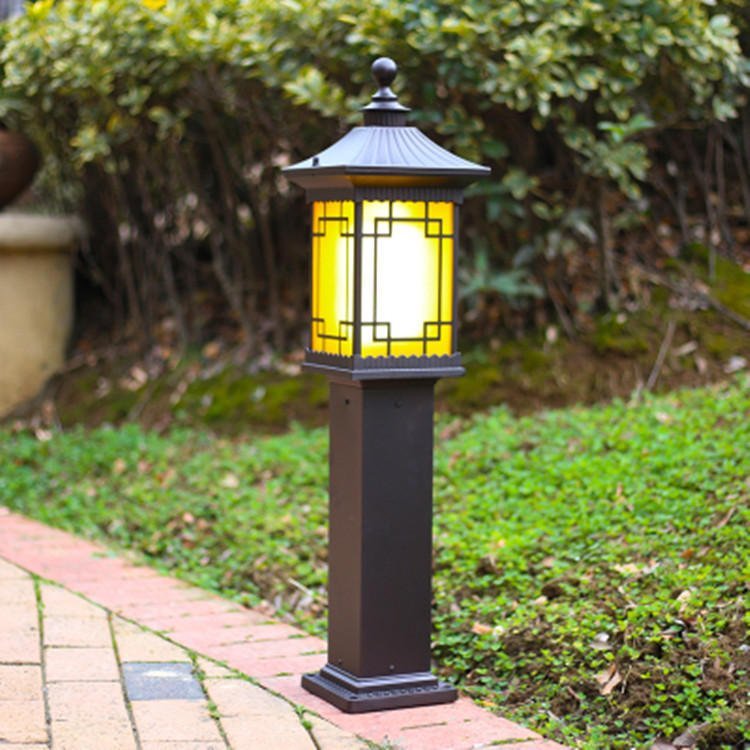
Comparing LED and HID Bollard Lights: Which Surpasses the Other?
LED and HID bollard lights stand as the two foremost choices in the market. Yet, determining the superior option can be a challenging task. Delve into the comparative analysis below to discover which one emerges victorious and the reasons behind its supremacy.
| Criteria | LED Bollard Light | HID Bollard Light |
| Technology | LED bollard light uses light-emitting diodes to illuminate. | HID bollard light uses high-intensity discharge of gas to illuminate light. |
| Energy-efficiency | Highly energy-efficient; consumes less energy than HID bollard light. | Less energy-efficient; consumes more energy. |
| Lifespan | LED bollard lights can last up to 50,000 to 100,000 hours. | HID lights typically last around 10,000 to 20,000 hours. |
| Replacement Requirements | Less frequent replacement or repair | More frequent replacement or repair |
| Instant Start | Reaches full brightness instantly | Require a warm-up time before reaching full brightness |
| Color Rendering Index | LED bollard lights offer better light quality and color rendering compared to HID bollard lights. | HID lighting usually has a weaker color rendering and may eventually show color shifts or inconsistencies. |
| Control Over Light Distribution | LED bollard lights provide directional lighting, giving better control over light distribution. | Older HID bollard lighting technologies, such as metal halide, offer less control over light distribution and may waste more light. |
| Light wastage | Minimal light wastage as the beam angle is customizable and gives directional lighting. | More light wastage compared to HID bollard light |
| Environmental Impact | LED bollard light emits less heat and doesn’t produce any harmful gas. | HID bollard lights contain mercury that is harmful to the environment. |
Upon evaluating the mentioned distinctions, it becomes clear that LED bollard lights surpass HID bollard lights in several aspects. Not only are they kinder to the environment, but they also demand a lesser share of energy consumption. Consequently, a noticeable reduction in your electricity expenditure is guaranteed. Furthermore, their low maintenance and replacement necessities ensure you can also retain a significant amount on upkeep costs!
Comparing LED Bollard Lights and LED Post Lights
Here are the distinctions between LED bollard lights and LED post lights:
| Criteria | LED Bollard Light | LED Post Light |
| Height | Bollard lights are usually shorter, ranging from 1 to 4 feet tall. | These lights are considerably taller, ranging from 8 to 20 feet. |
| Installation | These lights are typically installed closer to the ground and require an anchoring system to secure them. | Since LED Post Lights are positioned on long poles or posts, installation may be more complex and involve other factors, such as underground wiring. |
| Lumen/ Brightness | LED bollard lights provide subtle and directional lighting with a lower lumen rating. | LED post lights usually have higher lumen output and wattage options than LED bollard lights. |
| Application | LED Bollard Lights are commonly used in residential areas, commercial complexes, parks, gardens, and other outdoor spaces requiring clear guidance and low-level lighting. | LED Post Lights are primarily used in outdoor settings that require broad illumination, such as roadways, pathways, parking lots, and large open spaces. |
Comparing LED Bollard Lights and LED Landscape Spotlights
The distinctions between LED bollard lights and LED landscape spotlights are outlined below-
| Criteria | LED Bollard Light | LED Landscape Spotlights |
| Lighting purpose | LED bollard lights are mainly suitable for decorating and lighting pedestrian paths. | LED landscape spotlights are ideal for facade lighting and landscape lighting. |
| Beam angle | They have a wide range of beam angles reaching up to 360 degrees. | The beam angle of LED landscape spotlights is usually below 60 degrees. |
| Light-intensity | LED bollard lights usually have lower intensity than the spotlight. | These lights are high-intensity compared to LED bollard lights. |
| Lighting area coverage | The lighting of LED bollard fixtures can cover a large area. | LED landscape spotlights usually target a specific area. |
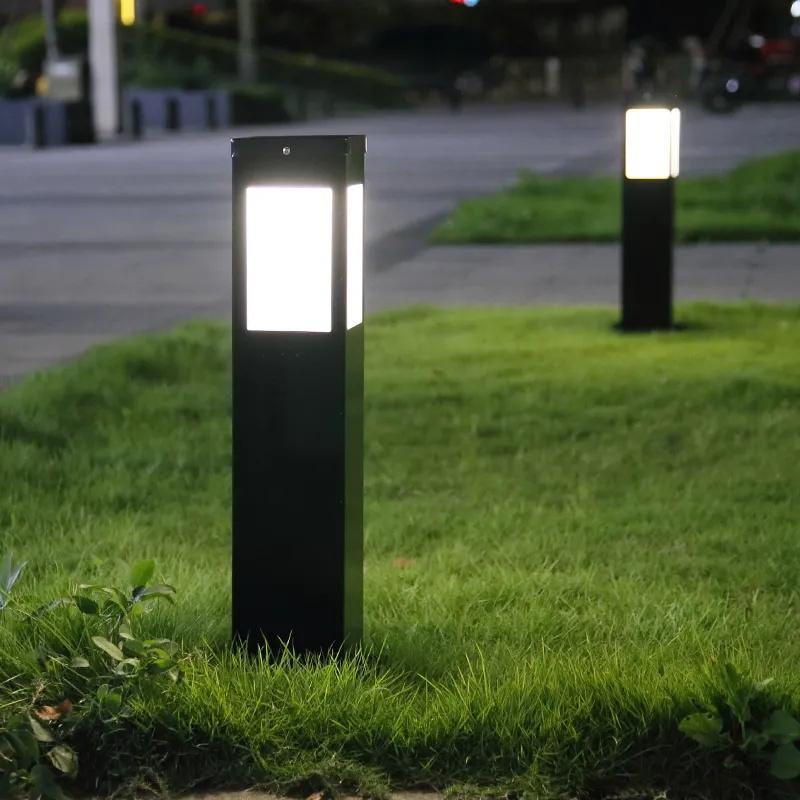
Conclusion
LED bollard lights stand out as the top contender when selecting the right kind of illumination for outdoor spaces. Perfect for lighting up walkways, parking areas, and residential and commercial locales, these fixtures guarantee optimal illumination and add an aesthetic appeal to your surroundings with varied designs and styles.
Selecting the perfect LED bollard light for your project necessitates careful deliberation on several vital aspects. These involve considering the beam angle, color temperature, dimensions such as height and diameter, and the IP rating of the unit, among other factors. Additionally, paying attention to the spacing or interval between each bollard is pivotal to achieving a harmonious setup.
However, your task doesn’t conclude at the selection stage; ensuring an accurate installation is equally important. To guarantee a seamless setup, it’s highly recommended to engage a seasoned electrician specializing in bollard light installations. Though this might entail an added expense, it promises precision and peace of mind knowing that your lighting is wired correctly and safely.
FAQs
You can use LED bollard lights in various outdoor settings, such as walkways, gardens, parking lots, driveways, and entrances. They are ideal for guiding pedestrians and enhancing security.
LED bollard lights are energy-efficient, durable, and require less maintenance compared to traditional lights. They also offer better lighting quality, are eco-friendly, and have longer lifespans.
LED bollard lights work by using LED technology to provide energy-efficient lighting. The light source is mounted in a post (bollard) and often diffused through a frosted lens for a soft, consistent glow.
The ideal color temperature for LED bollard lights is typically 3000K to 4000K (warm to neutral white), which provides a welcoming ambiance while offering sufficient visibility along pathways and outdoor spaces.
Yes, LED bollard lights are designed to be weather-resistant, often featuring IP65 or higher ratings, making them suitable for outdoor environments and able to withstand exposure to rain, dust, and other harsh conditions.
LED bollard lights are usually easy to install, often requiring minimal tools and simple mounting. Depending on the model, you may need to install them into the ground or on a flat surface with appropriate electrical wiring connections.

Hi, I’m Xylia Xiong, a sales professional with 14 years of experience in the LED strip light industry. I specialize in providing tailored solutions, leveraging my expertise in LED products and the latest industry trends. Known for effective communication and problem-solving, I’m dedicated to helping lighting manufacturers, importers, and distributors achieve their goals.
Let’s work together to create customized solutions that exceed expectations.
Related Posts

The Best LED Strip Lights You Can Buy Right Now

Comparing WS2811 Vs WS2812B: Key Differences


